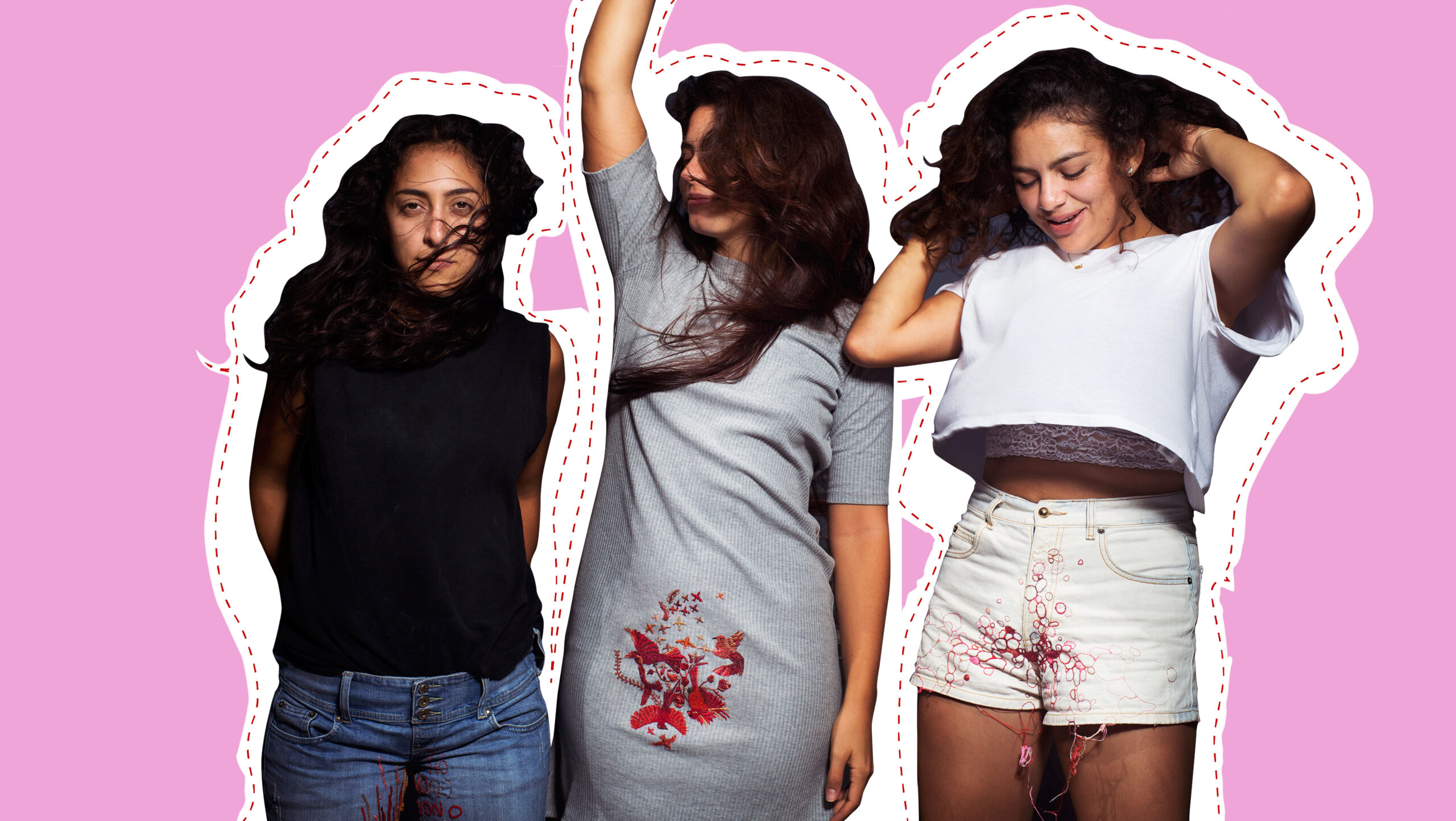This story is part of Seeing Red, a month-long series exploring periods from an LGBTQ2 perspective.
On a class trip to San Ramón to tour the jungle of Peru, 15-year-old Romina Chuls got her period. “I had a huge stain on my trousers,” she remembers. Chuls wrapped a T-shirt around her waist to hide it, and while her classmates swam in a nearby river, she stayed on the bus. “That was crazy, because going in the river would have helped wash the blood away from my clothes,” she says. “But I was 15 and too ashamed of showing my stain.”
Like many menstruating people, Chuls, now 27, used to worry about her clothes during her period. “I always had very painful periods,” she says. “And on top of the pain, I had to deal with shame because of stains.”
In 2016, two years after losing her grandmother to an accident, Chuls started to learn embroidery techniques by watching videos on Youtube. “My grandma was a very talented knitter,” she explains. “So I decided to take on her craft to feel close to her.”
One afternoon, she decided to combine her new skills to deal with an old issue. “I got this vision of an embroidery that looked like a period stain.”
She ran to the nearest shop to look for a pair of white jeans, an item she had always avoided buying, and, over the course of a couple of months, she stitched a beautiful red floral composition just under the crotch. “It was a rush of adrenaline,” she says. “Having the vision, drawing it and then stitching it up.”

Chuls later wore her creation on a walk in Miraflores, one of Lima’s most affluent neighbourhoods. “An elderly lady looked at me in shock,” Chuls says. “She was like, ‘You are so pretty, why do you wear those pants?’” A few months later, she assembled a group of friends to stitch their own period stains on their pants.
Chuls thinks the reaction of that woman is a reflection of the deeply-ingrained stigma around periods typical of all patriarchal societies, including her native country of Peru. And it’s why the artist, who is currently completing a residency at the Brooklyn studio of New York’s Textile Arts Center, decided to turn her personal vision into a participatory artistic project.
Qué Rico Menstruo, which roughly translates to “what a good period,” is an artistic movement that seeks to eradicate the stigma associated with menstruation. Chuls regularly leads workshops where attendees of diverse backgrounds — including LGBTQ2 people — can learn embroidery themselves. “I don’t want to sell my own designs because I want people to re-appropriate their own cycle,” she says. “So I teach them how to do it.” Since 2016, she’s worked with more than 80 participants. It’s her hope that period-stained clothes will become a trend. “Not a fashion trend, but a social trend,” she says. “I want people to be able to wear their periods.”
Chuls starts her workshops by asking participants to imagine what menstruation means to them. Some come up with familiar terms (“renewal,” “catharsis,” “flow”). Others associate menstruation with are more unusual things (“like a magazine — you never know what to expect with a new issue”). This first exercise helps participants identify what they want to stitch on their clothes. Many people look for inspiration in Chuls’ designs, which often feature positive images, like flowers and birds. She did, however, embroider a red scorpion after her friends complained that there weren’t enough designs reflecting the pain some people experience during their period.

People who join her classes are relieved to find a safe space to speak about their periods. “After my last workshop, one participant emailed me to thank me for the opportunity to talk about menstruation without stigma,” Chuls says. “People can be shy at the start, but they warm up as the workshop goes on.”
Despite the fact that roughly half the world’s population between the ages of 13 to 55 deal with periods, many people feel ashamed about it. According to a recent survey commissioned by period-proof underwear manufacturer Thinx, 42 percent of American women have been period-shamed, and nearly 58 percent feel embarrassed while on their period. “Seeing that my workshops help relieve people from this stigma fills me with a deep sense of hope,” Chuls says.
She has now started a private Facebook page to help participants keep in touch after taking part in her classes. “People often start their work during the workshop, but embroideries take long to complete,” she explains. “I hope that by keeping in touch they can find support to complete their designs.”
But Qué Rico Menstruo hasn’t always been a smooth ride. Chuls’ idea has attracted misogynist trolls since its early days. “When I first shared a photo of stained pants on Facebook, some people said it was disgusting.”
She’s even received photos of pants stained with feces. The trolling continued after she created an official page for the project. When some of her friends posted photos of their own stain embroideries with the caption “let’s make it a trend,” the page was flooded with harassment. “They were inundating our page with comments like cochinas [pigs],” Chuls says. “I think misogynists get scared when they see women acting together as a group.”
Despite the harassment, interest in Qué Rico Menstruo has steadily grown. Feminist groups from Peru, Mexico and Brazil have helped share Chuls’ idea on social media, and one of her previous workshops in Oaxaca, Mexico, was organized in co-operation with a local feminist group. Her workshops, which typically host about a dozen participants, are always full.

Chuls starts her workshops by asking participants to come up with words related to their periods. Credit: Courtesy Romina Chuls
At the core of Qué Rico Menstruo lies a wish to re-frame periods. “I hear a lot about normalization, but I don’t think that’s what we need,” Chuls says, adding that normalization can sometime be part of a capitalist drive to make periods “productive.”
In recent decades, ads for feminine hygiene products and painkillers have been promising women that they can have it all during their periods. But that message is at odds with Chuls’ vision. “That kind of language frames bodies as tools for labour,” she explains. “I want to create tools to help people listen to their bodies and embrace them for what they are.”
Instead, Chuls hopes she can help participants of Qué Rico Menstruo connect with their bodies in a more spiritual and artistic way, and come up with a design that feels honest. “You can stitch whatever you feel represents your period,” she says. “Just as long as it’s red.”

This story is part of Seeing Red, a month-long series exploring periods from an LGBTQ2 perspective.


 Why you can trust Xtra
Why you can trust Xtra


